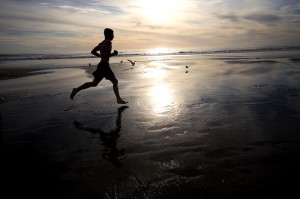 Is the way most people run wrong? It sounds weird given that the way you run is just the way you run, which, barring any injuries is the same way you have ran all your life. Recent research is suggesting that the kind of shoes we wear while engaging in jogging, running or sprinting has altered our form.
Is the way most people run wrong? It sounds weird given that the way you run is just the way you run, which, barring any injuries is the same way you have ran all your life. Recent research is suggesting that the kind of shoes we wear while engaging in jogging, running or sprinting has altered our form.
The research came about when scientists wanted to investigate the effects experienced when runners planted their feet before the invention of the modern running shoe. After all, humans have been running for a gazillion years (give or take a bazillion years) whereas the modern running shoe has only been around since the 70’s. What they found was that running shoes are so cushioned on the heel that it allows runners to strike the ground with this part of the foot first. This strikeforce can be up to three times your bodyweight. Obviously, the cushioning takes up some of the impact thereby making the form more comfortable, but compared to the form of running barefoot it does not look natural at all. It is not then surprising that so many suffer the hazards of shin splints, knee problems and sore feet. Check these two short youtube videos for comparison:
Not only is it thought that barefoot running form be the more natural style, it is also typically how most if not all professional athletes run. When you watch Usain Bolt tear down a 100m track he is making the initial impact with the balls of his feet as this is how the architecture of the foot and calf are designed for maximum force output. You will also note that athletes like sprinters do not wear heavily cushioned training shoes either. They wear very light sneakers with little to no heel cushioning. Fundamentally, they wear the sneakers at all for traction they offer by way of spikes.
So, were the $100 Air Max Classics you bought for your morning jog a waste? Not necessarily as you can slowly but surely alter your form so that you make initial impact with your forefoot, although you may end up with bumps and nubs on your toes. A better idea may be to actually start running barefoot be it on your local field, a school running track (not comfortable but you’ll get used to it), or best yet on soft sand if you live near a beach. Given the size of the United States I realize this is just not feasible for those of you who have yet to see the Ocean firsthand, nevermind have an available beach at your disposal.
Source: Lieberman DE, Venkadesan M, Werbel WA, Daoud AI, D’Andrea S, Davis IS, Mang’eni RO, Pitsiladis Y. Foot strike patterns and collision forces in habitually barefoot versus shod runners. Nature. 2010 Jan 28;463(7280):531-5.
